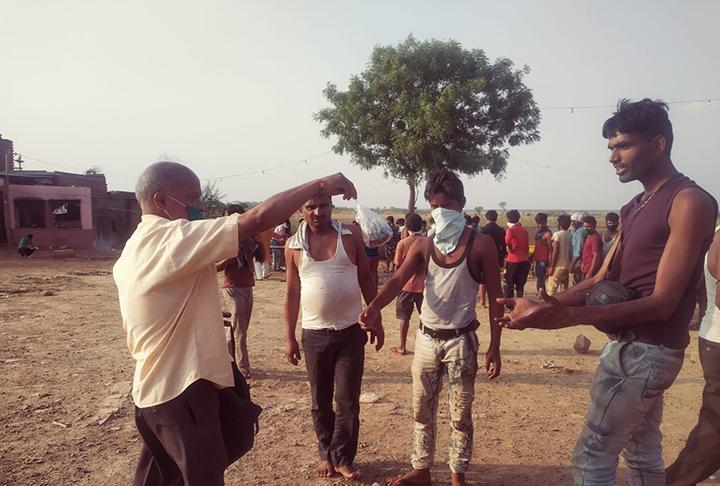
Last week, 29 labourers were admitted to a temporary hospital in Raksa, Jhansi on the border of Uttar Pradesh and Madhya Pradesh. They were going to their respective villages and suddenly fell sick due to extreme heat, as temperature hit 45 degree Celsius in various parts of India. All of them were suffering from heat stroke.
India is notching up new records in terms of temperature. On 26 May, Delhi’s Palam area recorded 47.6 degrees Celsius, the highest temperature in May in 18 years. Rajasthan’s Churu touched 50 degrees Celsius.
As migrant workers march homewards on foot during this Coronavirus outbreak, the heat wave is posing a big threat to life.
The most recent example of the seriousness of the situation can be understood through a video widely shared on social media from Muzaffarpur, Bihar where a 23-old mother of a toddler died of extreme heat and dehydration and the baby tries to wake her up. NDTV reported that she fell sick in a Shramik Special train due to lack of food and water.
The World Meteorological Organisation (WMO) recently warned nations that heat waves, along with Covid-19 can cause a lot of health risks. It urged countries to protect citizens from heat waves along with Coronavirus. Although there is no direct evidence linking transmission of Covid-19 and summer, scientists believe that it can worsen the impact of Coronavirus.
Heat waves due to climate change have become one of the deadliest silent natural disasters worldwide.
India is faced with heat waves at a time when it is planning staggered relaxation to bring the economy back on track, “India is experiencing a heat wave, and this is at the same time as India is relaxing the lockdown measures,” said WMO spokesperson Clare Nullis Kapp, during a virtual press briefing in Geneva.
On Tuesday, when temperatures went above normal, the India Meteorological Department (IMD) said that heat wave conditions occurred due to prevailing dry northwesterly winds over the plains of north-west India, central India and adjoining interior parts of eastern India. IMD said it was at its peak.
Every year from April to June, many Indian states reel under extreme heat waves, causing heat-related mortality. Government figures suggest that since 2015 at least 3,775 people died due to heat waves, while health activists say the actual figure can be way higher. Unfortunately, every year the disaster caused by heat waves never got much publicity. But it is a more serious problem when sizeable chunks of the population work in scorching heat and labour laws do not factor in heat waves during summer.
The National Disaster Management Authority (NDMA) defines heat wave as a “period of abnormally high temperatures, more than the normal maximum temperature that occurs during the summer season in the north-western parts of India.” The World Meteorological Organisation sets criteria to declare a heat wave: “A heat wave has five or more consecutive days during which the daily maximum temperature exceeds the average maximum temperature by five degrees Celsius. If the maximum temperature of any place continues to be more than 45° C bconsecutively for two days, it is called a heat wave condition.”
Atmospheric changes due to extreme temperature cause physiological stress among people living in these areas, sometimes even death. Doctors and health professionals say that high temperatures can cause dehydration, heat exhaustion and heat stroke. Heat can increase the severity of cardiovascular diseases.
Anup Kumar Srivastava, a drought and heat wave expert at the NDMA, while talking to Reuters, says that heat waves can overburden our hospitals, as Covid-19 infections have already overstretched our healthcare system.
He also demanded separate heat action plans as such plans can fight heat waves. In 2013, when 1,300 people died in Ahmedabad due to a heat wave, the city launched a heat action plan. That included early warning through mobile text, temperature display outdoors at important places, among other measures. Scientists believe that it was effective and helped reduce the number of deaths.
When the world is facing multiple crises — mostly linked to Nature, it is pertinent to recognise the severity of each crisis. Heat waves are a crisis induced by climate change and require more attention than the mere warning that authorities issue.
(Cover: Food distribution for labourer // Photo: Shubham Jain)
Police said despite sustained efforts, the accused remained at large and kept changing locations and…
At a debut solo exhibition in Delhi, an architect-artist explores sand, memory and movement through…
Om Taneja (81) and his wife Indira (77), a doctor, were kept under “digital arrest”…
The court observed although appellant had caused death by rash and negligent act, sending him…
AAP leaders were detained during a protest against the BJP over an alleged doctored video…
NDMC is rolling out a G20-style upgrade of roads, lighting and cleanliness to prepare Delhi…